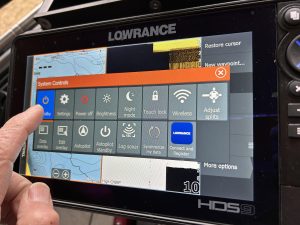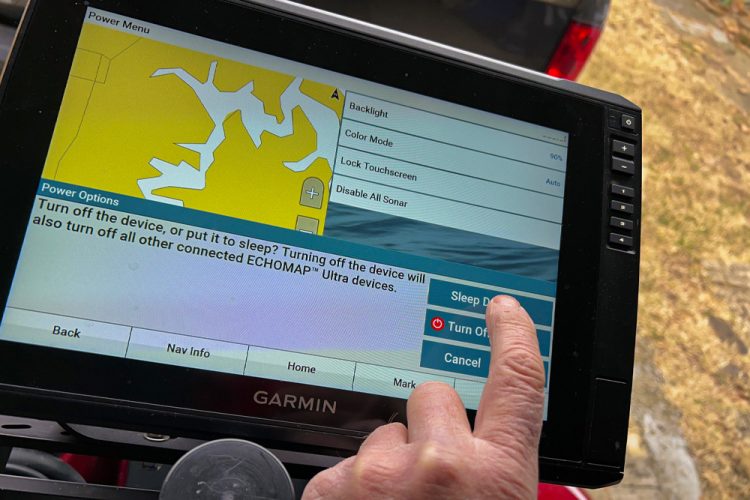Garmin’s home screen allows an angler to put the unit in sleep mode to conserve power.
Go to Sleep and Save Power
by Brad Wiegmann
Forward-facing modules use less power than a large screen sonar/GPS unit
One of the most underutilized modes on sonar units is the sleep/standby mode. In today’s world of multiple power-draining units on the front deck and additional units sometimes on the console, that seems crazy, right?

Reducing power consumption is the main reason to use sleep/standby mode. However, time management is another reason for the mode’s use. It seems like the newer-model sonar units take forever to come on after pushing the power button on. By not turning off and turning on a sonar unit, you no longer have to wait through the powering down and powering up cycles.
Basically, your unit or units sleep/standby mode is used to conserve power when an angler is not actively using the device, but allows it to quickly come back on when the power button or touch screen is activated. Sonar units are directly wired to a battery or power source and have no control over other marine modules. Note that devices like Garmin LiveScope, which are networked sonar devices, will keep pinging when the unit is in sleep mode unless the angler uses the “disable all sonar” button located in the power menu.
Power consumption will continue with modules connected by ethernet cable to sonar units like Garmin LiveScope, Lowrance ActiveTarget 2 or Humminbird MEGA Live imaging forward-facing sonar modules as they require an inline on/off switch to stop power draw from the battery or batteries. Typically, the inline on/off switch is used when the angler is done fishing for the day or when the transducer is out of the water and not being used.
Sonar units in sleep/standby mode will not transmit sonar imaging, and some will stop transmitting GPS. Most sonar units’ backlight or screen brightness will automatically dim when in sleep/standby mode.
How much power consumption is there when a sonar unit is powered up? Typically, a seven-inch sonar unit draws 0.8 amps an hour, a nine-inch sonar unit draws 1 amp an hour, a 10-inch unit draws 2 amps an hour and 12-inch sonar units draw 2.3 amps an hour. An angler with two sonar units plus a forward-facing sonar module drawing 1.5 amps per hour would use around 4 to 6 amps on an average fishing outing of 8 hours.
Although marine electronic manufacturers don’t publish what the reduction in power consumption is, it’s obvious that any angler can benefit from using the sleep/standby mode. Batteries are commonly the issue when it comes to power supply if you are putting your sonar units in sleep/standby mode.
Typically, the sleep/standby mode is found by pushing the power button on after the sonar unit has been on. A menu will appear giving an angler several choices from a menu, including the sleep/standby option. To turn the sonar unit back on, push the power button.
Although not an issue with power consumption, anglers can also use sleep/standby mode to resolve crosstalk issues.
(Brad Wiegmann of Springdale, Arkansas is a fishing guide, podcaster, social media influencer, professional photographer, videographer and outdoor writer published in dozens of print and electronic media outlets across the nation. Every month, he provides CatfishNOW readers with the latest information on the ever-changing world of fishing electronics. Learn more at BradWiegmann.com.)



